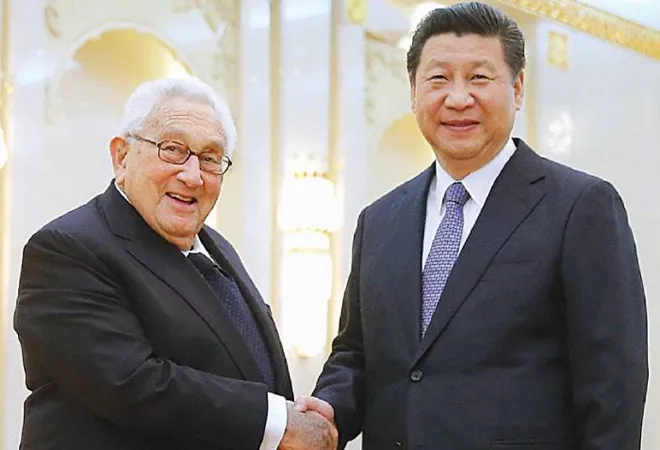-
CENTRES
Progammes & Centres
Location
In an effort to re-establish communication channels on various issues, recent high-profile diplomatic visits have been undertaken by Washington to Beijing

On 20 July 2023, a veteran diplomat and one of the most crucial figures in the history of United States (US)-China relations Henry Kissinger, made a visit to Beijing. President Xi Jinping hosted the former Secretary of State, who underlined, “The Chinese people never forget their old friends and Sino-US relations will always be linked with the name of Henry Kissinger”. President Jinping was referring to the role played by Kissinger in 1971, the year that marked the beginning of the normalisation of relations between the US and China. This eventually resulted in significant discussions between then US President Richard Nixon and China’s Zhou Enlai. This historical event continues to be highly respected in China.
Earlier in July this year, US Special Envoy on Climate John Kerry visited China. From 16 to 19 July, Kerry engaged in meetings with several high-ranking officials in Beijing. The US-China climate talks had been put on hold for almost a year due to the visit by US House of Representatives Speaker Nancy Pelosi to Taiwan on 2 August 2022 despite China’s opposition. China considers Taiwan as part of its territory and claims sovereignty over it.
US Treasury Secretary Janet Yellen was also there in Beijing from 6 to 9 July 2023. Secretary Janet L. Yellen made progress in restoring some balance to the strained economic relationship between the US and China. While the trip was a significant step in easing relations, it did not result in any major breakthroughs.
The US-China climate talks had been put on hold for almost a year due to the visit by US House of Representatives Speaker Nancy Pelosi to Taiwan on 2 August 2022 despite China’s opposition.
Before Yellen, Secretary of State Antony Blinken had travelled to China on 18 and 19 June this year. He was the first Secretary of State to do so in the past few years since 2018. Blinken’s visit was a testimony that after the bilateral relationship hit a never-before low, efforts for reinvigorating ties and ensuring stability were necessary. During his two-day visit to Beijing, Blinken engaged in discussions with China’s highest-ranking foreign policy officials and also had the opportunity to meet with the country’s leader, Xi Jinping, before concluding his visit.
In a bid to enhance dialogue with China, CIA Director William Burns also conducted a visit to Beijing in May 2023. During this significant encounter, Director Burns engaged in discussions with his Chinese counterparts, underscoring the criticality of sustaining transparent communication within intelligence channels.
Blinken’s visit was a testimony that after the bilateral relationship hit a never-before low, efforts for reinvigorating ties and ensuring stability were necessary.
Now looking at each of the visits closely, it becomes imperative to decipher the motives and outcomes behind them, as all the high-profile visits happened in a of two months. To do that, it is equally important to note the results of these meetings individually.
Chinese authorities were eager to prioritise commerce as a cornerstone in US-China relations, urging Treasury Secretary Janet L. Yellen and Commerce Secretary Gina Raimondo to visit first. However, American officials insisted that Secretary of State Antony J. Blinken should precede them. While Blinken’s visit may have thawed the freeze in high-level bilateral diplomacy, it also underscored the precarious state of dialogue between the two countries due to China’s stance on Taiwan and the growing military and economic competition.
Blinken’s visit to China presented limited opportunities for manoeuvring, highlighting the dilemma faced by the Biden administration. On the one hand, the administration is intensifying hard power tactics against China back in Washington while simultaneously expressing its desire to engage in responsible competition, cooperate on global challenges like climate change, and protect American businesses from the consequences of great power rivalry. Experts opine that it remains uncertain whether the administration can effectively balance these objectives as China seems to be sceptical of this approach and is not convinced by the proposed strategy.
The administration is intensifying hard power tactics against China back in Washington while simultaneously expressing its desire to engage in responsible competition, cooperate on global challenges like climate change, and protect American businesses from the consequences of great power rivalry.
Both sides agreed to continue consultations on the guiding principles of China-US relations. Blinken reiterated Washington’s commitment to the “One China” policy, emphasising that it does not support Taiwan’s independence but remains dedicated to ensuring Taiwan’s ability to defend itself against any aggression. A significant unresolved matter was re-establishing military-to-military communication between the US and China. The contacts between the highest-ranking military officials from both countries had been suspended. Despite Blinken’s repeated emphasis on the necessity of such channels during his meetings, no immediate advancement was achieved in this regard.
Following a four-day visit to Beijing, special climate envoy John Kerry’s efforts did not yield concrete results, but Kerry emphasized its purpose was to facilitate progress in climate change discussions. The focus area for potential advancement is methane emissions, a potent greenhouse gas. China expressed its intention to develop a plan to reduce methane emissions during the 2021 COP26 meeting with the United States, but it has not made it public yet. If China commits to methane reduction before or during COP28, it would be a significant achievement for Kerry to address critics in Washington. Despite significant differences, the meeting’s readouts suggest a positive view on climate cooperation from all parties. Chinese Premier Li showed openness to pragmatic institutionalized cooperation for multilateral climate governance, and Vice President Han Zheng mentioned the potential for both countries to make new contributions to addressing climate change. As agreed in the joint declaration, this could imply an enhanced working group and potentially new commitments in China’s Nationally Determined Contributions (NDC).
If China commits to methane reduction before or during COP28, it would be a significant achievement for Kerry to address critics in Washington.
Although the White House clarified that Kissinger’s visit was of private nature. Kissinger, during his trip, had meetings with China’s top diplomat, Wang Yi and Defence Minister Li Shangfu. “China is willing to discuss with the US side the right way for the two countries to get along and promote the steady progress of China-U.S. relations,” is what President Xi had to say on Kissinger’s meeting.
While the meetings might have made some progress in stabilising the relationship, tensions between the US and China remain significant. China’s demands include lifting technology restrictions, reduced support for Taiwan, and an end to what they perceive as a containment strategy centred on strengthening security ties with US allies and partners in the Asian region. If the Biden administration decides to impose new restrictions on American investments in Chinese companies related to quantum computing, artificial intelligence, and semiconductors, the ties between the two nations could face further strain. Analysts believe that China’s warm reception of Kissinger illustrates how Beijing is utilising non-official diplomatic channels to expand the impact of its message and attempt to influence the thinking of Washington. As Beijing has grown more doubtful and occasionally openly frustrated with the Biden administration, it has sought to engage with individuals it perceives as being more sympathetic to its stance.
According to American officials, Blinken’s trip was essential because it is crucial to uphold consistent high-level diplomacy between the two leading superpowers, who are also the largest economies and militaries globally. Maintaining such diplomatic engagement is vital to prevent open conflict. Both governments, as well as their allies and other nations, seek stability in the relationship. Diplomacy provides a platform for both sides to express their perspectives openly and privately during discussions.
As Beijing has grown more doubtful and occasionally openly frustrated with the Biden administration, it has sought to engage with individuals it perceives as being more sympathetic to its stance.
It is clear that tensions between the world’s two largest economies have escalated concerning various matters, including the conflict in Ukraine, Taiwan, and trade restrictions. In an effort to re-establish communication channels on these and other issues, recent high-profile diplomatic visits have been undertaken by Washington. It will be a matter of time to know to what extent the relationship has been revived with the recent visits and dialogues; however, it appears that China is resolute in its stance on Taiwan, leading to a cautious approach in its dealings with the US. On the other hand, Washington seems determined to move forward and navigate the situation despite the prevailing tensions. The economy remains an essential aspect for China, whereas a peaceful and steady relationship for cooperation in realms like military and climate remains a crucial priority for the US.
Uday Nitin Patil is a doctoral candidate at the Department of Geopolitics and International Relations, Manipal Academy of Higher Education.
The views expressed above belong to the author(s). ORF research and analyses now available on Telegram! Click here to access our curated content — blogs, longforms and interviews.

Uday Nitin Patil is a Dr. T. M. A. Pai Doctoral Fellow at the Department of Geopolitics and International Relations Manipal Academy of Higher Education ...
Read More +